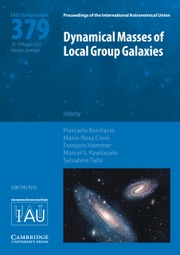Crossref Citations
This article has been cited by the following publications. This list is generated based on data provided by
Crossref.
Teyssier, Romain
and
Commerçon, Benoît
2019.
Numerical Methods for Simulating Star Formation.
Frontiers in Astronomy and Space Sciences,
Vol. 6,
Issue. ,
Varidel, Mathew R
Croom, Scott M
Lewis, Geraint F
Brewer, Brendon J
Di Teodoro, Enrico M
Bland-Hawthorn, Joss
Bryant, Julia J
Federrath, Christoph
Foster, Caroline
Glazebrook, Karl
Goodwin, Michael
Groves, Brent
Hopkins, Andrew M
Lawrence, Jon S
López-Sánchez, Ángel R
Medling, Anne M
Owers, Matt S
Richards, Samuel N
Scalzo, Richard
Scott, Nicholas
Sweet, Sarah M
Taranu, Dan S
and
van de Sande, Jesse
2019.
The SAMI Galaxy Survey: Bayesian inference for gas disc kinematics using a hierarchical Gaussian mixture model.
Monthly Notices of the Royal Astronomical Society,
Vol. 485,
Issue. 3,
p.
4024.
Beattie, James R
Federrath, Christoph
and
Seta, Amit
2020.
Magnetic field fluctuations in anisotropic, supersonic turbulence.
Monthly Notices of the Royal Astronomical Society,
Vol. 498,
Issue. 2,
p.
1593.
Varidel, Mathew R
Croom, Scott M
Lewis, Geraint F
Fisher, Deanne B
Glazebrook, Karl
Catinella, Barbara
Cortese, Luca
Krumholz, Mark R
Bland-Hawthorn, Joss
Bryant, Julia J
Groves, Brent
Brough, Sarah
Federrath, Christoph
Lawrence, Jon S
Lorente, Nuria P
Owers, Matt S
Richards, Samuel N
López-Sánchez, Ángel R
Sweet, Sarah M
van de Sande, Jesse
and
Vaughan, Sam P
2020.
The SAMI galaxy survey: gas velocity dispersions in low-z star-forming galaxies and the drivers of turbulence.
Monthly Notices of the Royal Astronomical Society,
Vol. 495,
Issue. 2,
p.
2265.
Körtgen, Bastian
2020.
The turbulence driving parameter of molecular clouds in disc galaxies.
Monthly Notices of the Royal Astronomical Society,
Vol. 497,
Issue. 1,
p.
1263.
Mohapatra, Rajsekhar
Federrath, Christoph
and
Sharma, Prateek
2020.
Turbulent density and pressure fluctuations in the stratified intracluster medium.
Monthly Notices of the Royal Astronomical Society,
Vol. 500,
Issue. 4,
p.
5072.
Menon, Shyam H
Federrath, Christoph
Klaassen, Pamela
Kuiper, Rolf
and
Reiter, Megan
2020.
On the compressive nature of turbulence driven by ionizing feedback in the pillars of the Carina Nebula.
Monthly Notices of the Royal Astronomical Society,
Vol. 500,
Issue. 2,
p.
1721.
Acharyya, Ayan
Krumholz, Mark R
Federrath, Christoph
Kewley, Lisa J
Goldbaum, Nathan J
and
Sharp, Rob
2020.
Quantifying the effects of spatial resolution and noise on galaxy metallicity gradients.
Monthly Notices of the Royal Astronomical Society,
Vol. 495,
Issue. 4,
p.
3819.
Seta, Amit
and
Federrath, Christoph
2020.
Seed magnetic fields in turbulent small-scale dynamos.
Monthly Notices of the Royal Astronomical Society,
Vol. 499,
Issue. 2,
p.
2076.
Mathew, Sajay Sunny
and
Federrath, Christoph
2021.
The IMF and multiplicity of stars from gravity, turbulence, magnetic fields, radiation, and outflow feedback.
Monthly Notices of the Royal Astronomical Society,
Vol. 507,
Issue. 2,
p.
2448.
Cielo, Salvatore
Iapichino, Luigi
Günther, Johannes
Federrath, Christoph
Mayer, Elisabeth
and
Wiedemann, Markus
2021.
Visualizing the world’s largest turbulence simulation.
Parallel Computing,
Vol. 102,
Issue. ,
p.
102758.
Gerrard, Isabella A
Federrath, Christoph
Pingel, Nickolas M
McClure-Griffiths, Naomi M
Marchal, Antoine
Joncas, Gilles
Clark, Susan E
Stanimirović, Snežana
Lee, Min-Young
van Loon, Jacco Th
Dickey, John
Dénes, Helga
Ma, Yik Ki
Dempsey, James
and
Lynn, Callum
2023.
A new method for spatially resolving the turbulence-driving mixture in the ISM with application to the Small Magellanic Cloud.
Monthly Notices of the Royal Astronomical Society,
Vol. 526,
Issue. 1,
p.
982.
Beattie, James R
Federrath, Christoph
Kriel, Neco
Mocz, Philip
and
Seta, Amit
2023.
Growth or Decay – I: universality of the turbulent dynamo saturation.
Monthly Notices of the Royal Astronomical Society,
Vol. 524,
Issue. 3,
p.
3201.
Hew, Justin Kin Jun
and
Federrath, Christoph
2023.
Lagrangian statistics of a shock-driven turbulent dynamo in decaying turbulence.
Monthly Notices of the Royal Astronomical Society,
Vol. 520,
Issue. 4,
p.
6268.
 $\mathcal{M}$ = 11±3. Combining these with turbulence simulations to constrain the plasma β = 0.34±0.35, we reconstruct the turbulence driving parameter b=0.22±0.12 in G0.253+0.016. This low value of b indicates solenoidal (divergence-free) driving of the turbulence in G0.253+0.016. By contrast, typical clouds in the Milky Way disc and spiral arms have a significant compressive (curl-free) driving component (b > 0.4). We speculate that shear causes the solenoidal driving in G0.253+0.016 and show that this may reduce the star formation rate by a factor of 7 compared to nearby clouds.
$\mathcal{M}$ = 11±3. Combining these with turbulence simulations to constrain the plasma β = 0.34±0.35, we reconstruct the turbulence driving parameter b=0.22±0.12 in G0.253+0.016. This low value of b indicates solenoidal (divergence-free) driving of the turbulence in G0.253+0.016. By contrast, typical clouds in the Milky Way disc and spiral arms have a significant compressive (curl-free) driving component (b > 0.4). We speculate that shear causes the solenoidal driving in G0.253+0.016 and show that this may reduce the star formation rate by a factor of 7 compared to nearby clouds.



